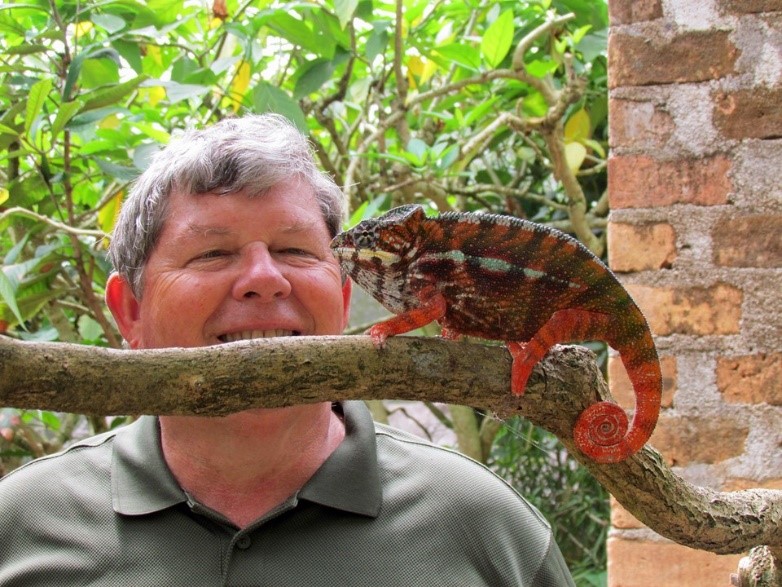
By: 4 Old Soles (My Parents)
Madagascar is an absolutely amazing country to visit, filled with incredible things to do, fantastic places to stay and a completely unmatched biodiversity. There is nowhere else on earth like it!
But if you are looking to visit, it can be really hard to know where to go, what to do and even where to start? This is where I’d like to help. Below, I’ll share with you our top sites, our favorite lodges and tips on how we planned our 13-day Madagascar adventure (without using a tour company!)
For our trip to Madagascar we chose to work directly with a local guide. And I can show you how to do this too! Traveling and working directly with the local guides, to me, provides a much more intimate travel experience and lets you really see the best of Madagascar.
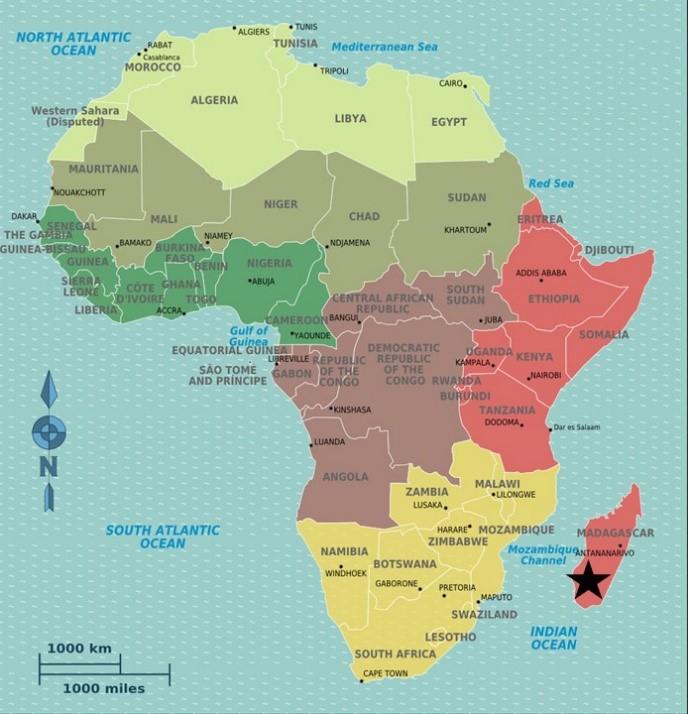
WHERE IS MADAGASCAR & WHY IS IT SO BIODIVERSE?
Madagascar, is a large island located off the southeast coast of Africa.
Approximately 88 million years ago, the island of Madagascar split off from the Indian subcontinent. It has remained biologically isolated since. Approximately 95 percent of Madagascar’s reptiles, 89 percent of its plant life, and 92 percent of its mammals that exist here, exist nowhere else on Earth. Due to this unique biodiversity, Madagascar is often referred to as “the 8th continent.”
The people, referred to as “Malagasy,” are also unique. In the north and east they are a blend of Indian Ocean traders – Indian, Arabian, Indonesian and later French and Portuguese. And in the south and west, the people of Madagascar look more distinctly African.
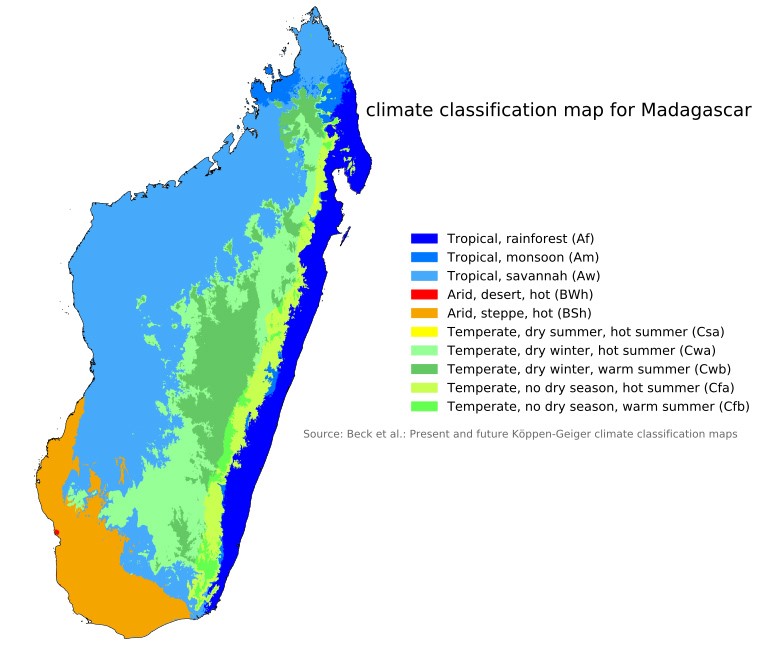
THE GEOGRAPHY OF MADAGASCAR
The center of Madagascar is considered the central highlands. Here there are extensive temperate rainforests with terraced, rice-growing valleys.
To the west of the central highlands, the terrain becomes more tropical and more arid as it slopes down to the Mozambique Channel and the mangrove swamps along the coast.
The western and southern sides of Madagascar, which lie in the rain shadow of the central highlands, are home to dry deciduous forests, deserts and xeric shrublands. These areas are less populated than the central highlands.
We decided to concentrate our adventure in Madagascar to the central highlands, with a few days along the more arid terrain of the southwest coast.
(See Map Below)
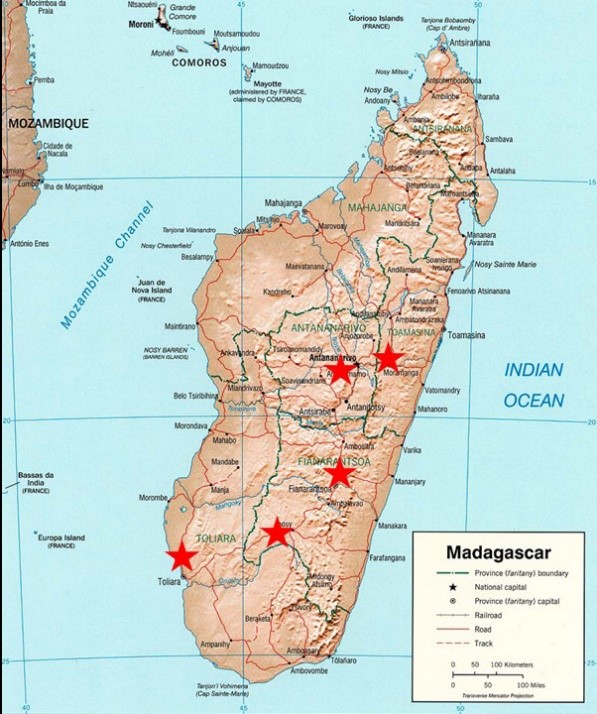
TIPS ON HOW TO PLAN A VISIT TO MADAGASCAR
Madagascar is the perfect place for a “TOURS BY LOCALS” tour.
Tours By Local is a company dedicated to connecting travelers with highly qualified local tour guides. In Madagascar, they work with approximately 10 local guides who offer tours ranging from several hours to over 20 days in length. On their site you can easily see what types of tours are offered, their lengths, descriptions of the guides and how to conveniently contact the guide themselves! Then you can work directly with your guide regarding the tours they offer and make any tweaking of the schedule you’d like for while you are there.
Check out “Tours By Locals” tour options here.
Experiencing the country with a personal guide has so many advantages. You travel close to the people, you eat meals where locals eat, you can visit local homes and talk with and see their daily activities. Your guide is your encyclopedic window into understanding the people and the culture. And know that Tours By Locals guides in 3rd world countries, are among the best educated people in the country and being a guide here is a well-paid and respected profession.
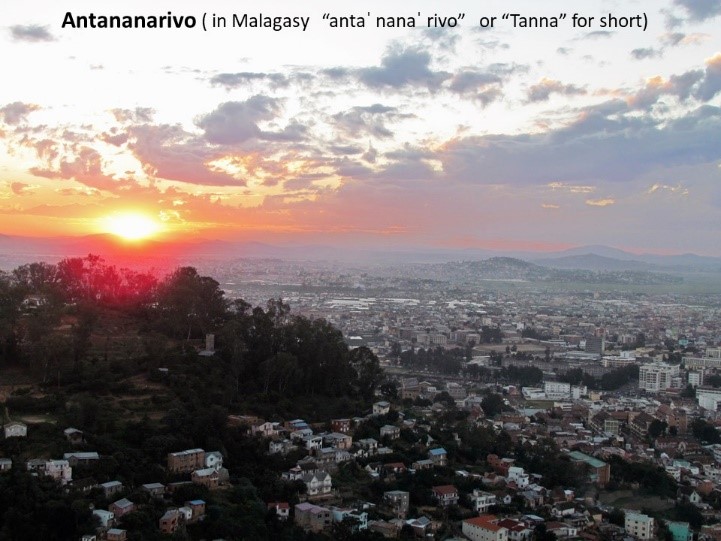
Our Madagascar Tour Overview
For our tour we began our travels in the capital, where we flew in. Then we traveled south though the countryside and worked our way to the southern city of Toliara, on the Straits of Mozambique. Then we flew back to the capital to return home. On the map above, our primary site seeing areas are represented by the red stars.
Traveling Tips
The roads in Madagascar can be spotty, slow and full of potholes, so the amount of distance you can traverse in a day is variable.
HOW LONG TO VISIT MADAGASCAR?
Personally, I recommend taking between 10 and 14 days, if you are able to, in order to experience the best of Madagascar.
Our trip was 13 days and we thought this gave us a good overview of the country.
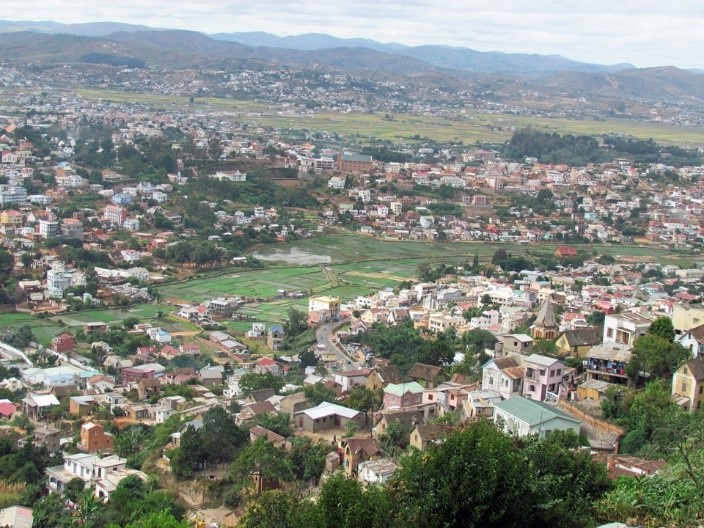
FANTASTIC THINGS TO DO IN MADAGASCAR
ANTANANARIVO, MADAGASCAR (“Tanna”)
We began our tour in the capital of Madagascar, Antananarivo (also known as “Tanna” for short.)
The city of Antananarivo is built among a series of pretty rolling hills. Its streets are twisty and narrow which I found very interesting. I recommend a full day tour here in order to see the Palace of Queens, the National Museum and the King’s Palace – a World Heritage site.
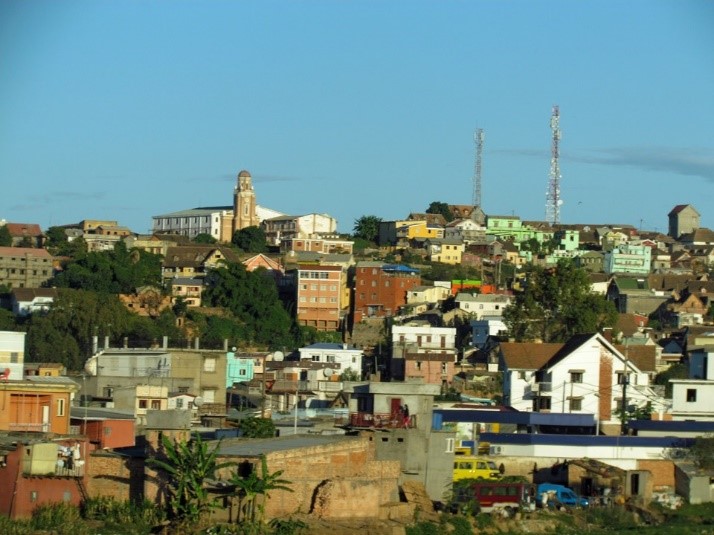
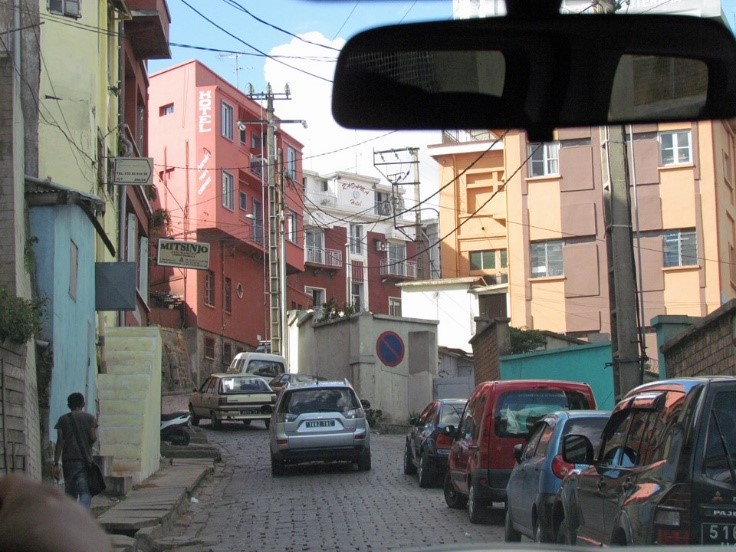
WHERE TO STAY IN ANTANANARIVO, MADAGASCAR
We stayed at the Lokanga Boutique Hotel (6 rooms) – This is a genuine traditional Malagasy House, in all red bricks. Our room had a balcony with breathtaking views over the city.
Lokanga is centrally located in the heart of an historical area, perched on the royal hill of Antananarivo – only steps away from the Queen’s Palace. All the rooms are individually styled and decorated with family antiques and full comforts with amazing views. The wonderful in-house French Restaurant serves the local community as well. (See pictures below)
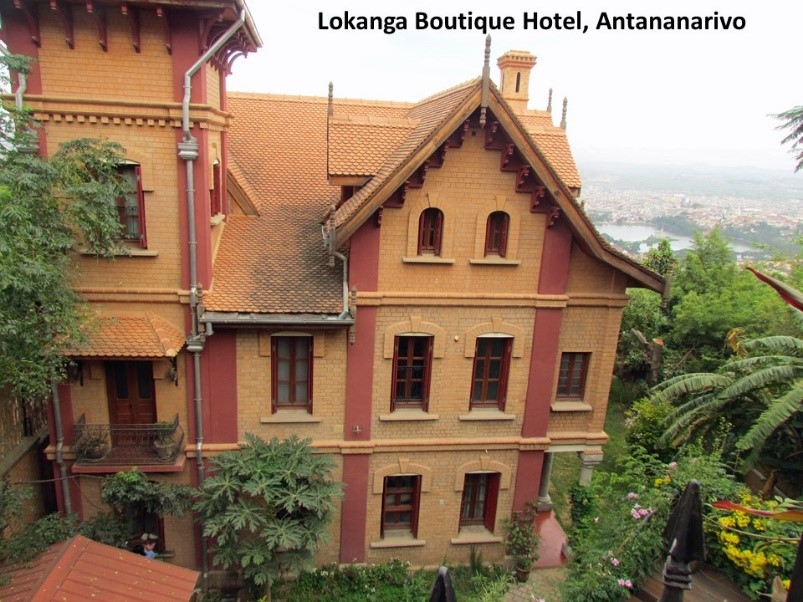

From the capital, we traveled on twisty roads through small villages and rice fields towards the eastern part of the island.
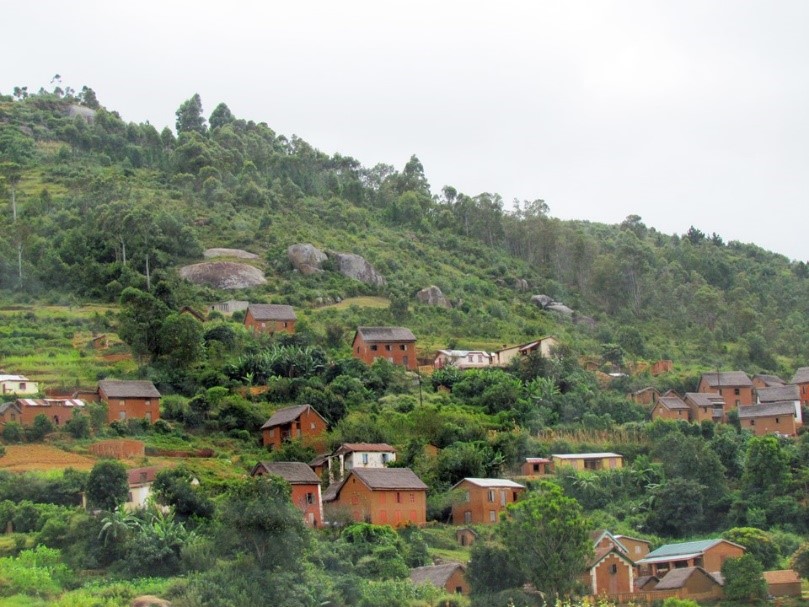
It was April, and the day was crispy cool. We also noticed how the buildings in this area did not look like typical African homes, but instead looked more like what you would see in France or Italy. They were very picturesque, even though they were often poor.
PEREYRAS RESERVE
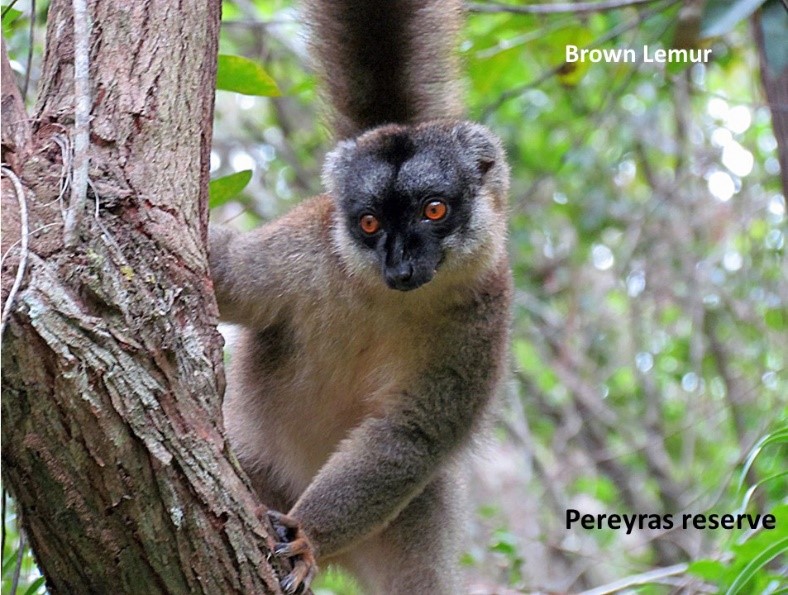

Our first stop, east of “Tanna,” was at the privately-owned Pereyras Reserve. Here we had our 1st glimpse of Madagascar’s unique biodiversity. First, a park guide took us on a 1-hour hike to view the lemurs in the forest. This was an amazing experience!
Then we went to their fantastic Chameleon Sanctuary where they have sixty distinct species that are only found in Madagascar! Chameleons are known for their ability to change color as these reptiles can alter their appearance in response to changes in temperature, light, and mood. By rotating each eye independently, chameleons are able to see all sides and directions without moving their heads, making meals out of flies instantaneously! We even got pictures of two throwing their tongue out to catch grasshoppers! This is such a wonderful place to take pictures and visit.
ANDASIBE-MANTADIA NATIONAL PARK
Our next stop was Andasibe-Mantadia National Park.
Here we went on a 2-3 hour walk through the rainforest with a park guide. We found the Indri lemurs, which are one of the largest lemurs and they have a lovey thick black and white coat – very beautiful! The Indri is known for its loud, distinctive songs and this helped us locate them within the forest. We also saw the Diademed Sifaka lemur which has a golden stomach, arms and legs and black back and black and white face (They also have the red-bellied lemur and the brown lemur.)
It was incredible trouping through the rain forest on the lookout for lemurs! We heard their singing and hooting. And we saw many of them gracefully fly from one tree to another. Sometimes they would jumped 30’ from one tree to another. This was amazing to watch!
Then we made our way to our lodge for the evening.
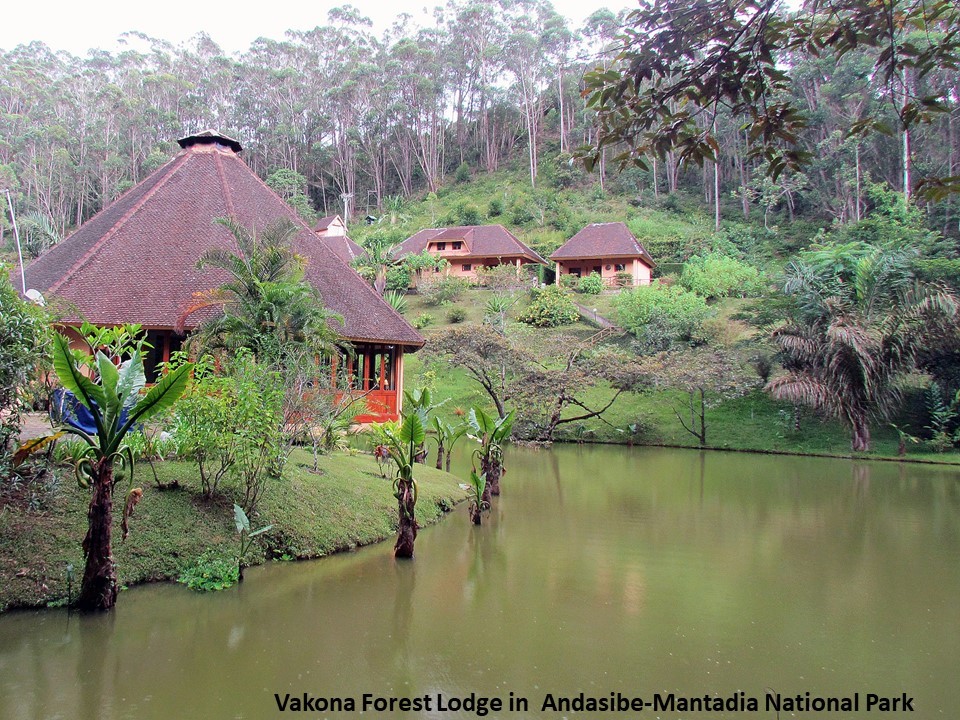
WHERE TO STAY NEAR ANDASIBE-MANTADIA NATIONAL PARK
Vakona Forest Lodge
We stayed at the Vakona Forest Lodge. It is located in a beautiful setting on the southern side of the Andasibe-Mantadia National Park. But one of the things that makes this lodge incredibly unique is that they own a private reserve called “Lemur Island.” This was an absolute highlight of our 2-weeks in Madagascar.
At Lemur Island we got into a small canoe and were rowed around a beautiful area with small islands, tall trees and grass. We then stopped to walk around on one of the islands. And soon lemurs came from all directions to greet us!
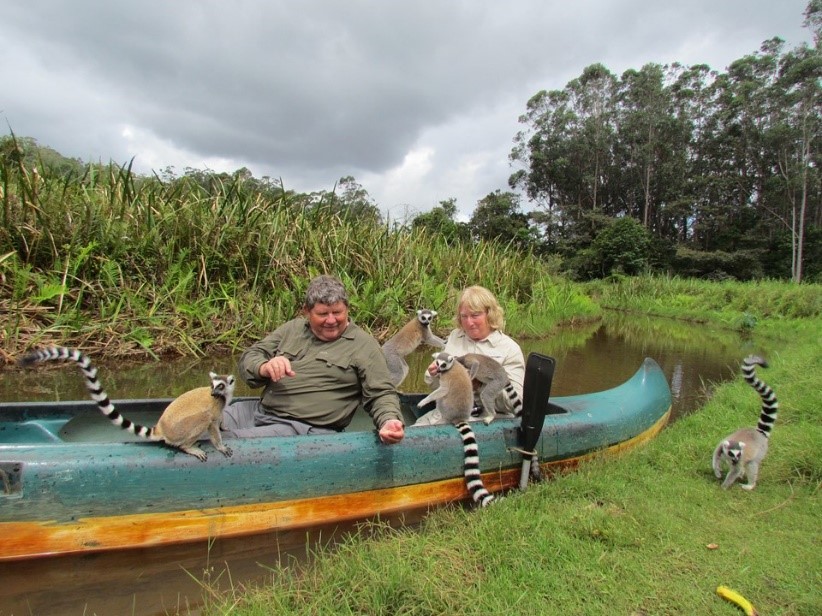
Now on Lemur Island, the guide does bring some food to entice the lemurs to come closer, and I understand that there is some controversy to this, understandably so. But here on Lemur Island, the story is that supposedly the lemurs on this island were rescued from the captive wildlife trade and that they were too used to humans to be released back into the wild. This is why they are tame enough to be fed and interact with humans, yet still considered to be living “wild” on this unique island.
If you do decide to visit Lemur Island, just know that there is something truly exhilarating about having a lemur come down out of the trees, sit on your shoulder and lick the sweat off your face. This is an experience not to be forgotten and I wish we had scheduled two visits!
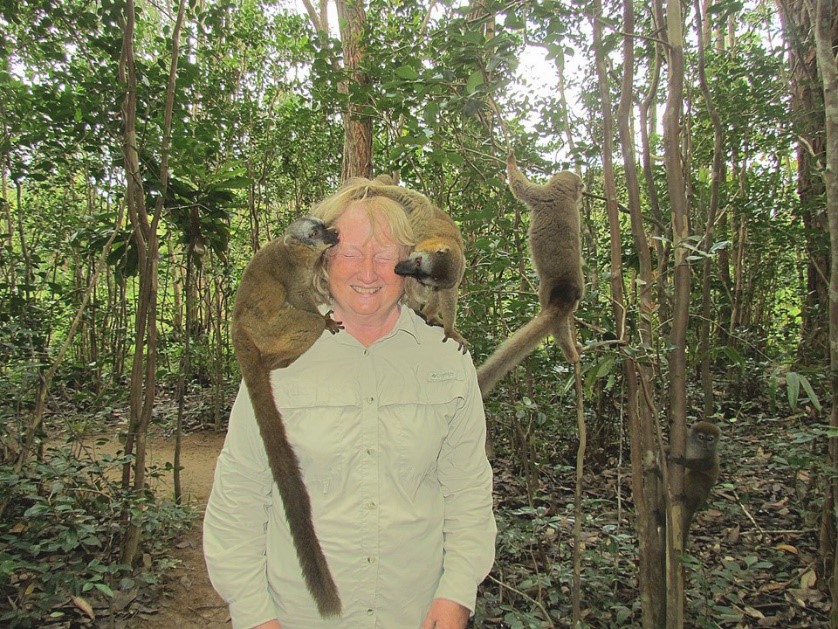
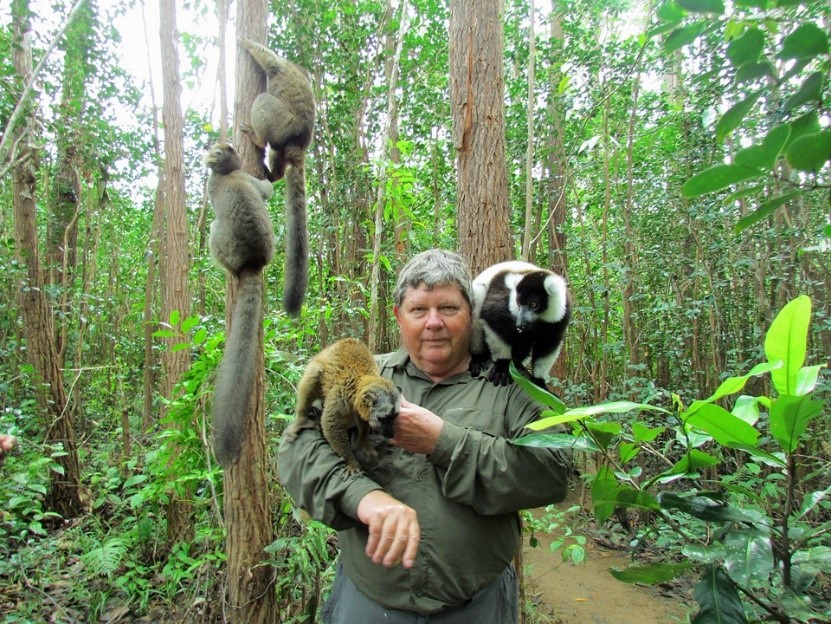
A Great Compact Wildlife Guide For Your Trip:
Our All-Day Drive South to Antsirabe
After visiting the Andasibe-Mantadia National Park (and then Lemur Island), we began our drive through the countryside, along the windy roads towards Antsirabe. The roads here were sometimes extremely poor, but it was interesting to see the life of the people as we drove by.
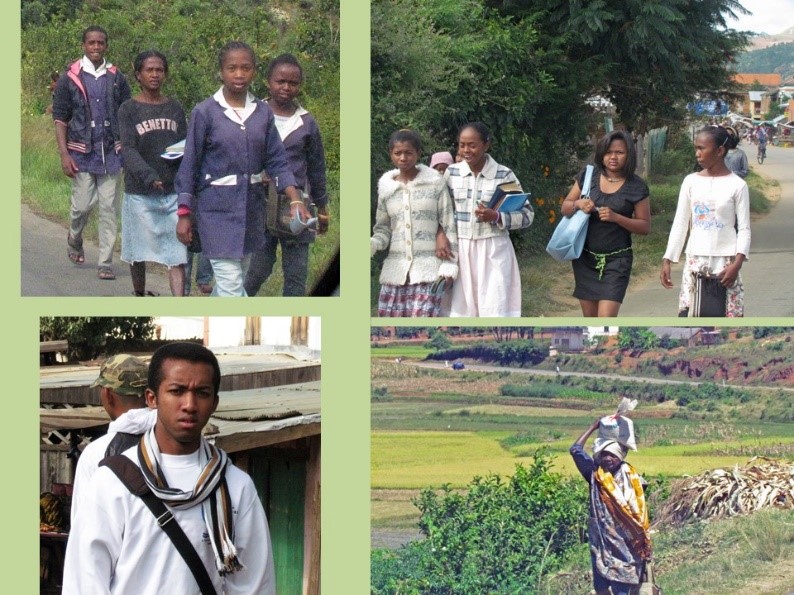
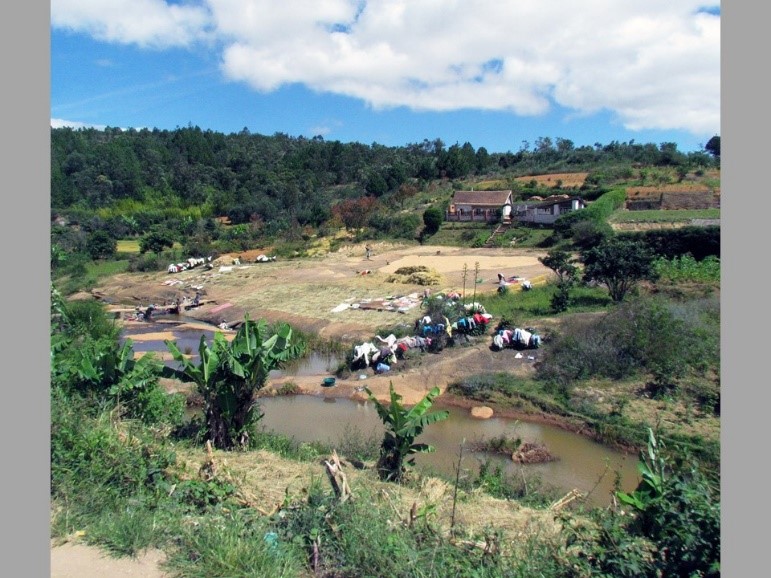
On our drive, we saw a lot of children walking to school. Our guide told us how here many children walk long distances to get to school. We saw many people carrying items on their heads, even some children. We also saw several oxcarts hauling things, many trucks and a lot of traffic for this narrow road with many potholes.
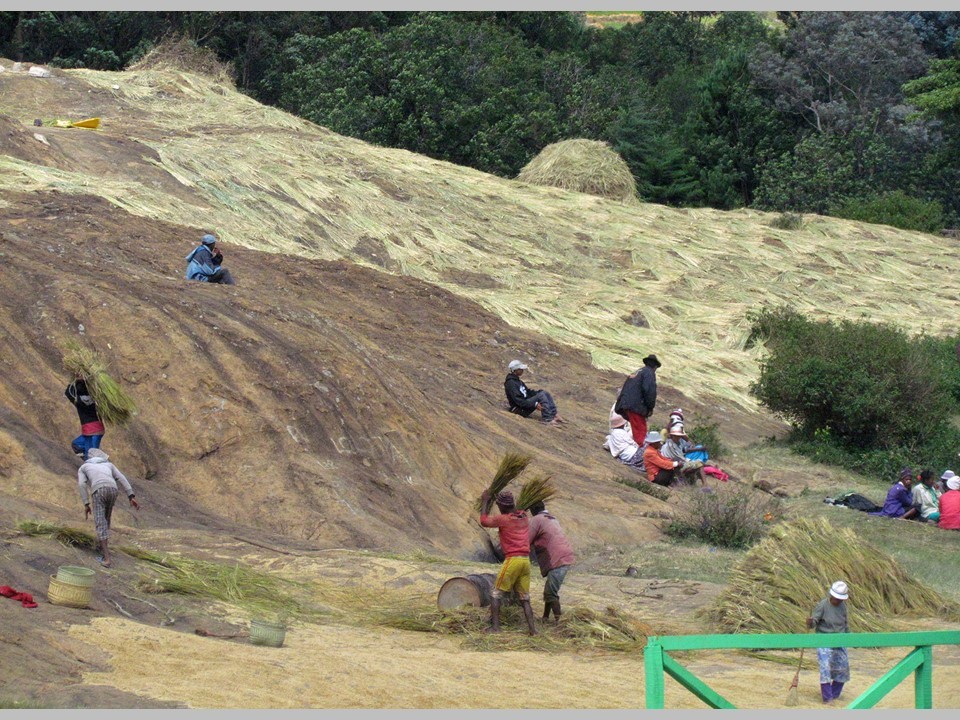
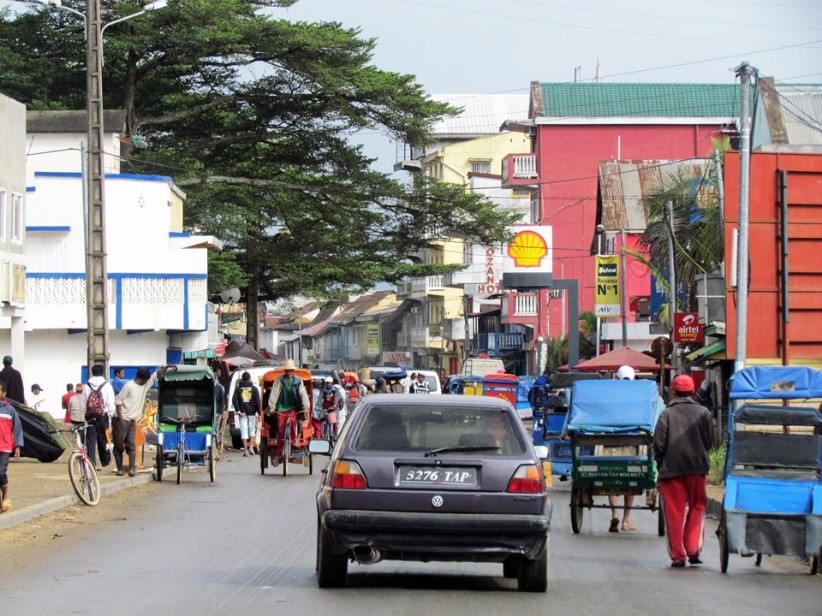
When we arrived in Antsirabe we saw many rickshaws and push/pull carts (these are carts pulled by men who take passengers or goods, and they pull the cart while running barefoot on the road!) This area is known for this and it was interesting to see.
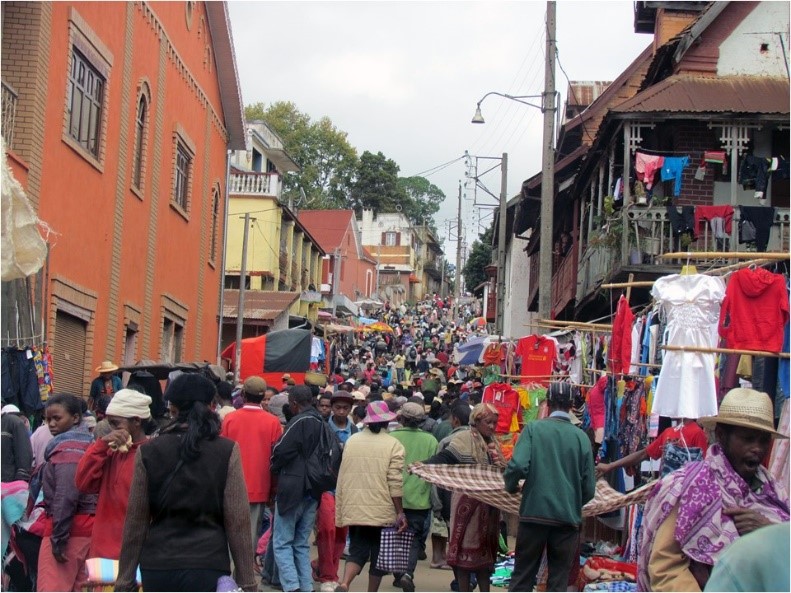
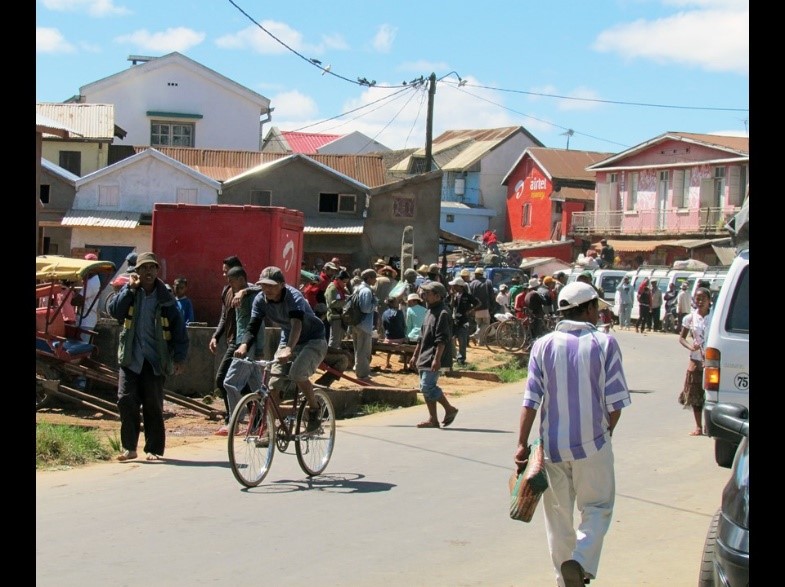
WHERE TO STAY IN ANTSIRABE
Couleur Café Hotel
If you are visiting Antsirabe, the Couleur Café Hotel is an excellent choice for rest and rejuvenation. It is well-known for its family-friendly environment and its convenient proximity to great restaurants and attractions. The Couleur Café Hotel makes it easy to enjoy the best of Antsirabe, especially market day.
Our All-Day Drive From Antsirabe to Ranomafana
We drove all day on the high plateaus through picturesque gently rolling mountains. There were wide valleys of rice fields with frequent villages of 1 to 3-story red adobe homes. Much of this rural area has no electricity except in the larger towns.
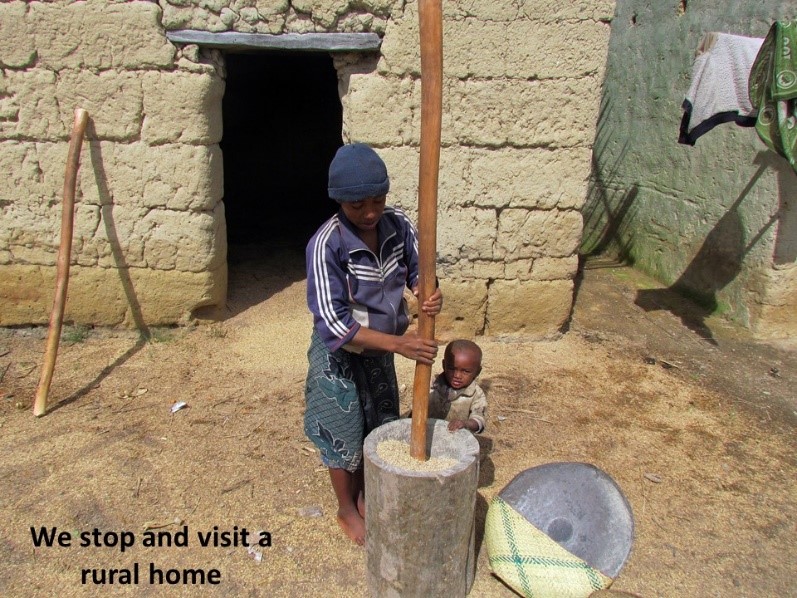
Along the way, we stopped by a local home in a small village because the mother was hand grinding wheat by the side of the road. Within minutes, the entire village gathered to see what was happening. We asked for a tour of their home, and she seemed delighted to show us everything, including the parents “loft “ bedroom with a picture of Barrick Obama on the wall. This was a spur-of-the-moment experience that you could never get if you were on a big tour! We gave the mother an appropriate donation for the tour and thanked her greatly.

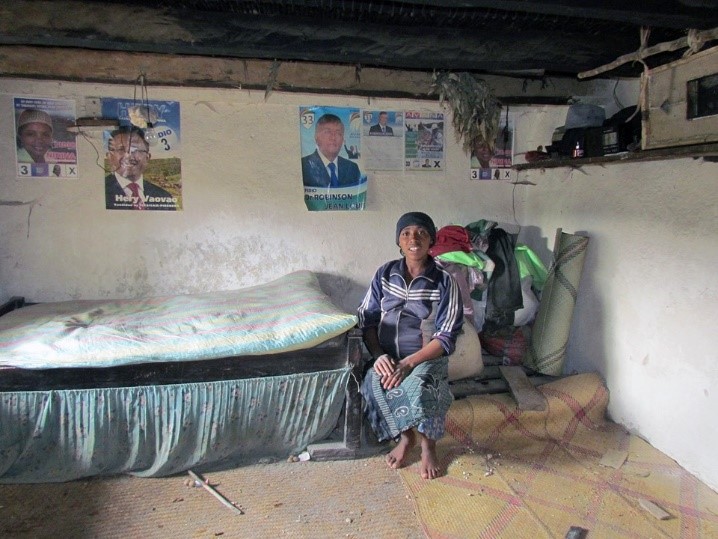
As we approached Ranomafana National Park, the terrain became more mountainous, and the weather for us was overcast and rainy. We were scheduled for a 3-hour hike in this temperate rainforest, but the weather did not cooperate. It began to rain pretty hard so we chose to spend our day at our lodge.
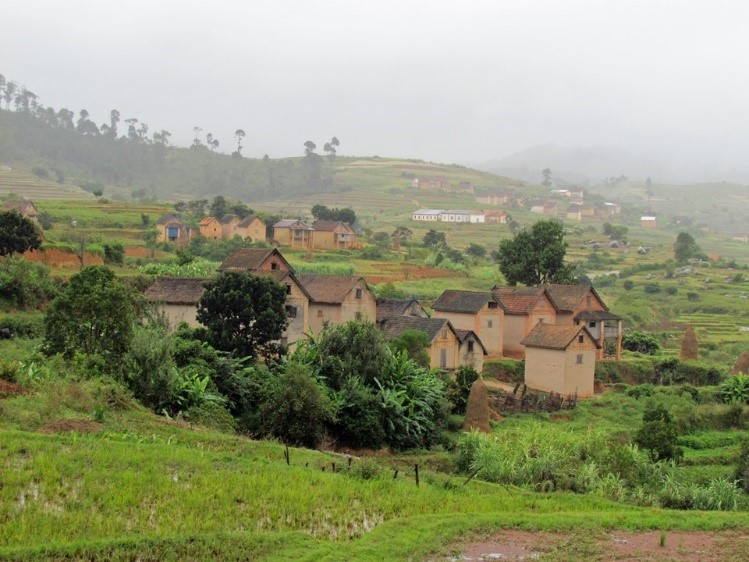
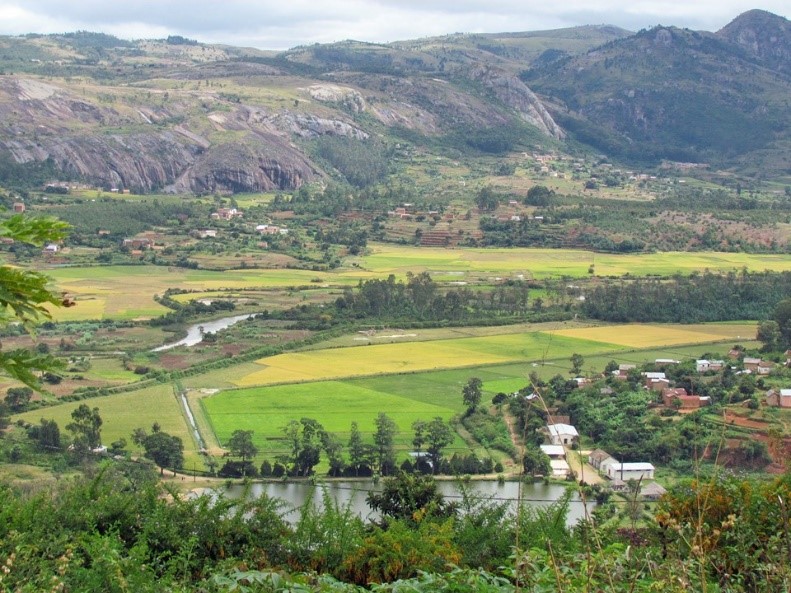
WHERE WE STAYED IN RANOMAFANA NATIONAL PARK
Setam Lodge
The Setam Lodge is set above the river valley, in a heavily forested area just inside the boundaries of the Ranomafana National Park. Each of the bungalows provided scenic views from their perched hilltop location of the dense rainforest and river below. The rooms were basic but the dining room food was quite good and with a large variety of choices. This was surprising to us being so far from a major town.
Our Drive to Fianarantsoa
Fianarantsoa is Madagascar’s 2nd largest town. It is a cultural and intellectual center for the whole island. Here we had a local guide lead us on a short walking tour of the old town of Fianarantsoa, which is perched high on a scenic hillside. The old town has been restored with the help of donations from all over the world, but honestly we didn’t think that there was that much to see.
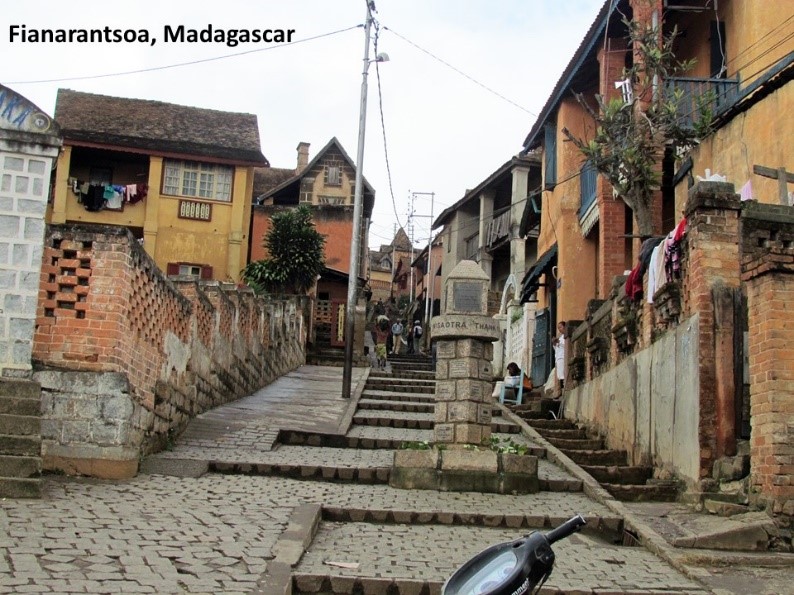
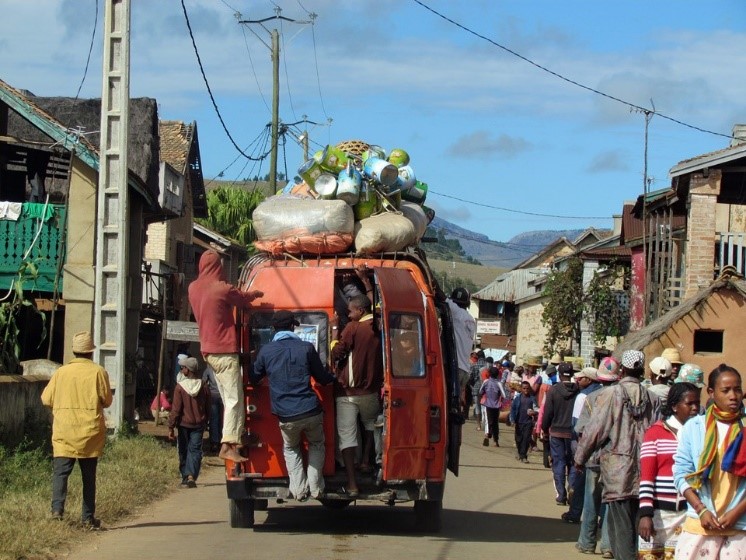
WHERE TO STAY IN FIANARANTSOA
Tsara Guest House
We stayed at the wonderfully quaint Tsara Guest House and it has a particularly excellent restaurant attached to it.
Our Drive from Fianarantsoa to Isalo National Park
We left the Highland and came off the plateau. It was a long way down. Now we were entering into the arid region of Madagascar, which is flatter.
On our drive, we ran into a HUGE swarm of locust and later, a place where the dead locust was gathered and dried for local consumption. I was told that they are tasty and provide a lot of protein.
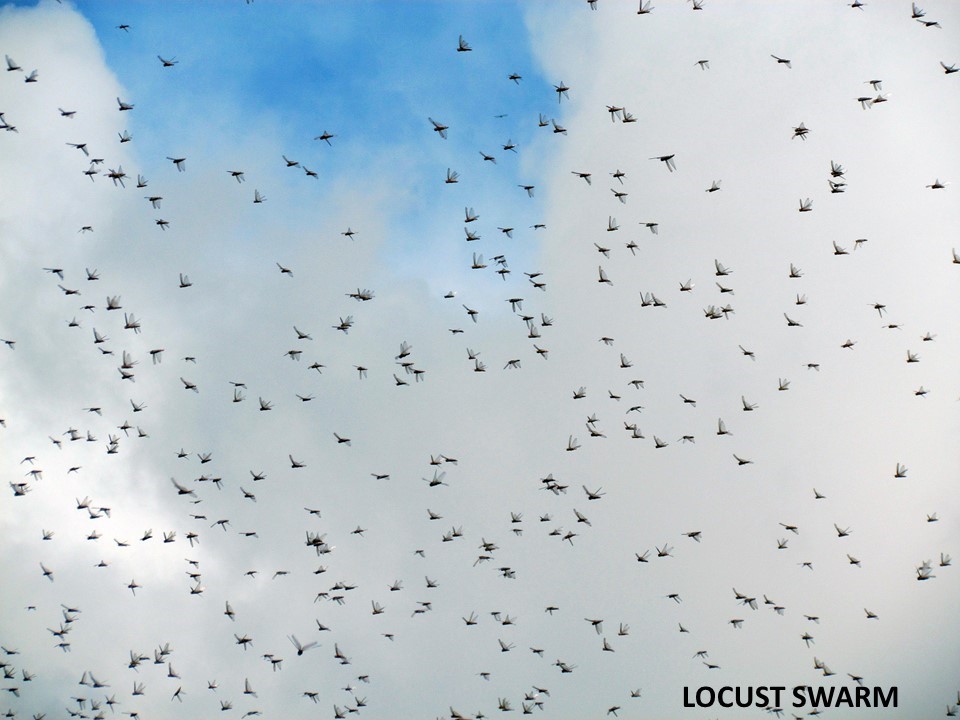
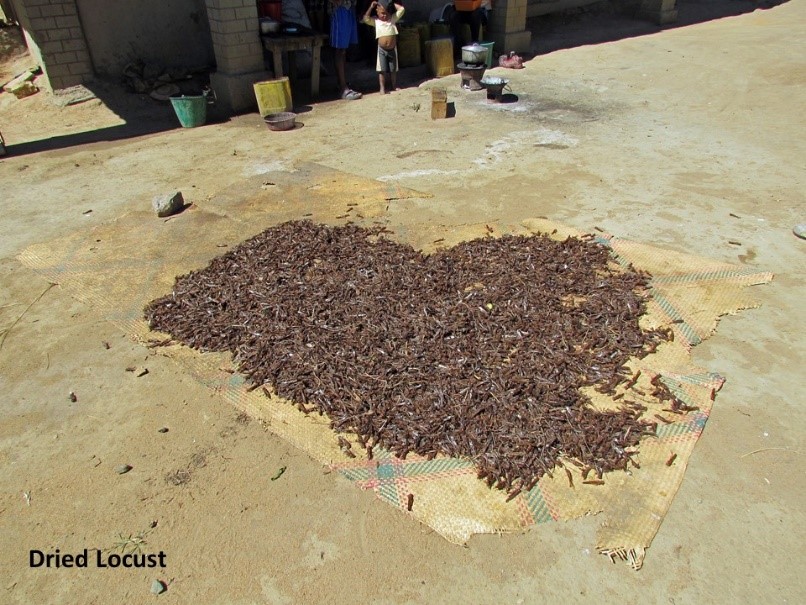
We also observed several hundred cows, being driven down the road, in small groups of about 25, all going to market in a town that was some distance away.
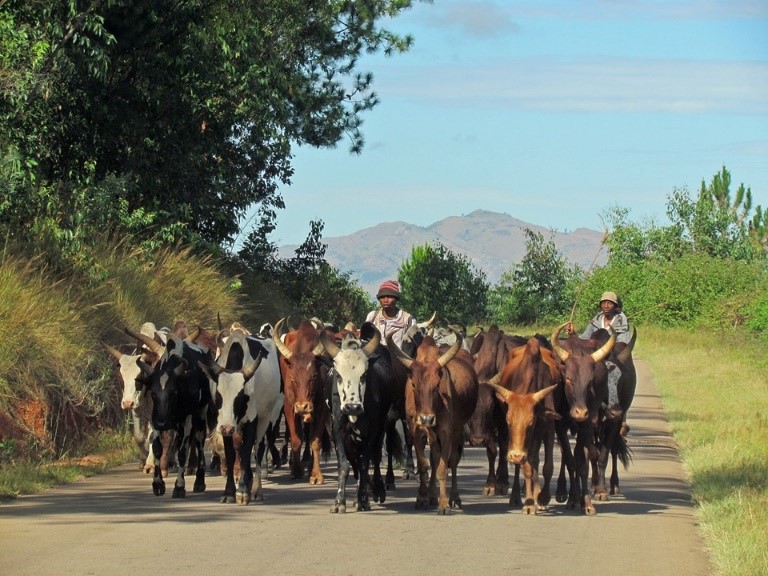
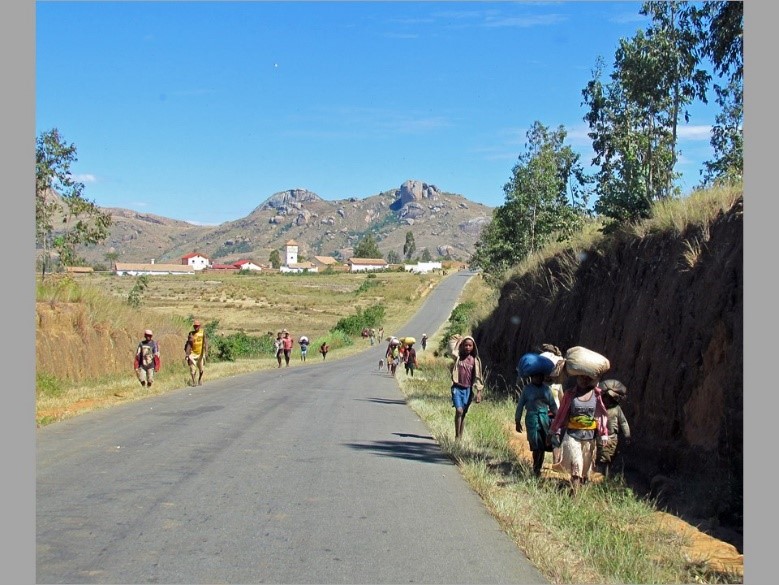
During our drive our guide told us that here the government owns the land and that people can move onto any piece of vacant land. And after they live on that land and farm it for 20 years, then it is theirs.
As we drove on, the villages began to take on a more African look, with thatched roofs.
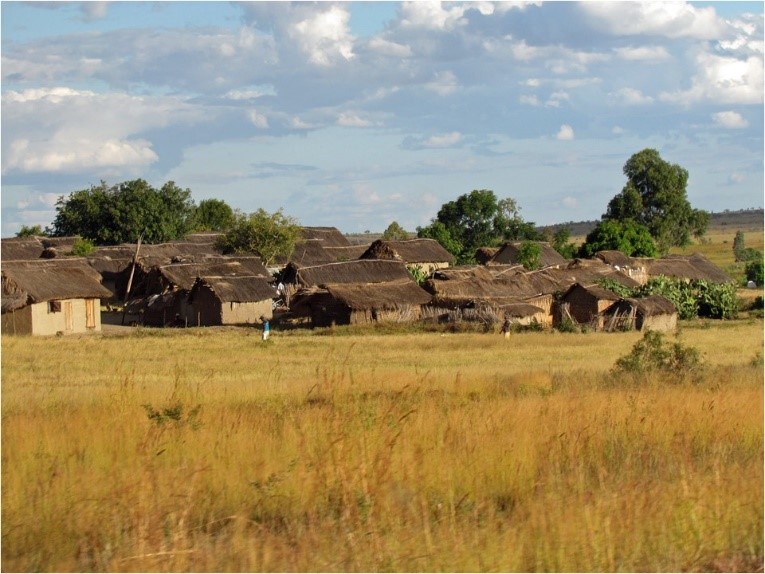
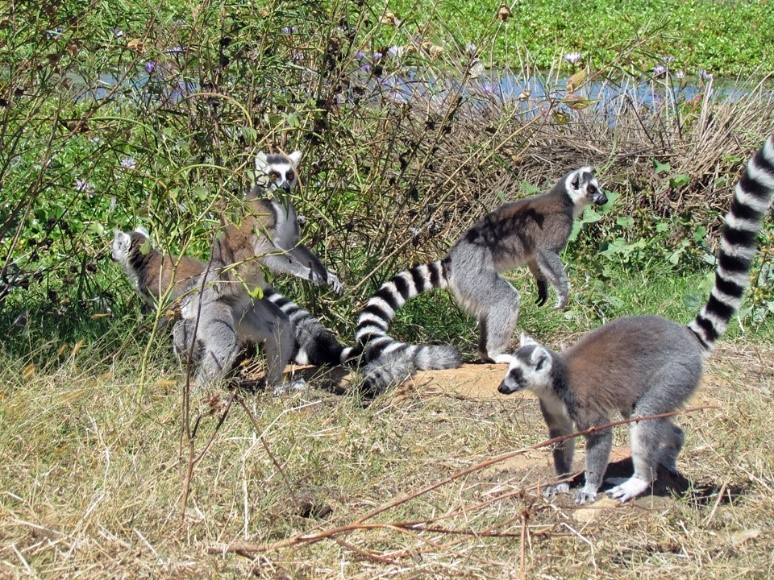
We stopped at a roadside restaurant near Ranohira. They had a private-preserve, wooded area out back with a small hiking trail. We hiked for about an hour with a local guide and saw many Ring-Tailed Lemurs.
ISALO NATIONAL PARK
Isalo National Park has barren landscapes, twisted sandstone rock formations and extraordinary plants. The park offers different multi-hour hikes to view the landscape, the flora and the fauna. We hiked for 1.5 hours along the trails in the park. We saw a couple of ring-tailed lemurs and we also saw their silk worms. They have the Chinese silk worms in the cities to make silk, but these live only in the wild and only eat the leaves of a certain tree that grows in this region. The people here gather their cocoons for silk, but don’t get much. We also saw a plant that scientists use to make medicine for leukemia.
The most interesting animal we came across was an insect that looked a little like a praying mantis. It was on a bush and our guide told us about where it was, and we still had a hard time seeing it – it looked like a stick (see below).
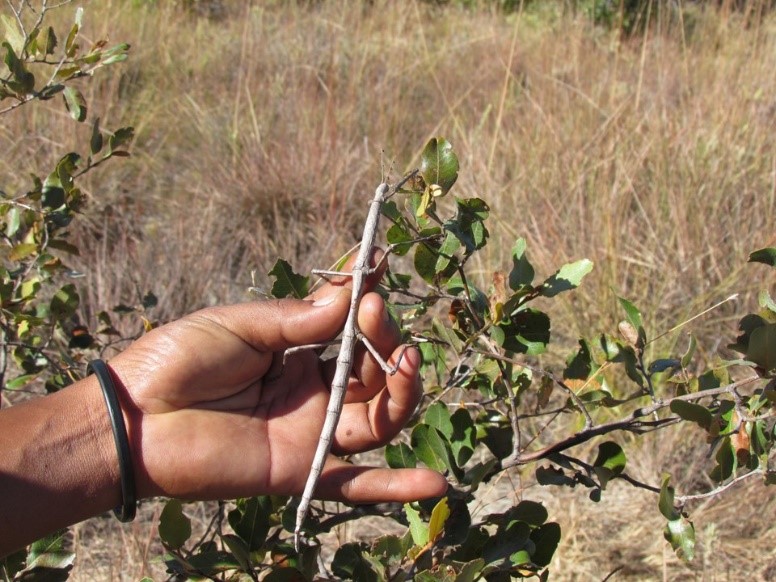
The sandstone cliffs here at Isalo National Park are part of the original earth that first emerged from the sea 250 million years ago, and this area plus part of southern Africa is among the oldest dry land on earth!
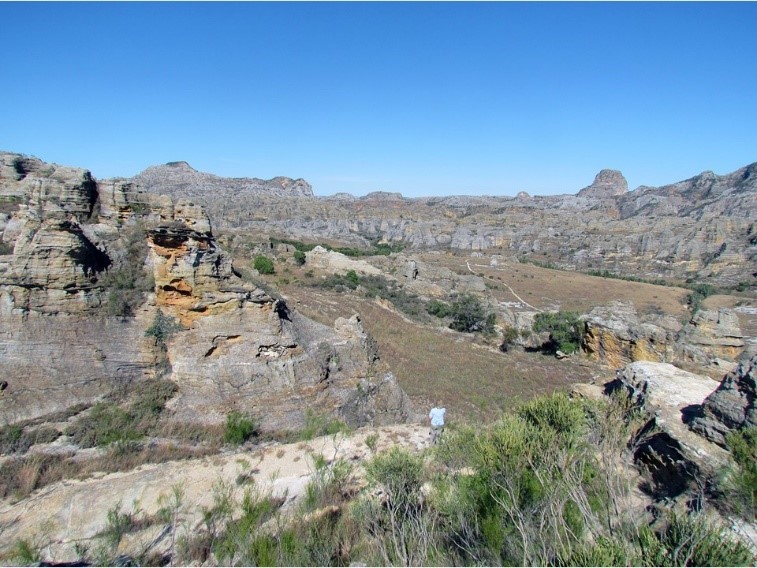
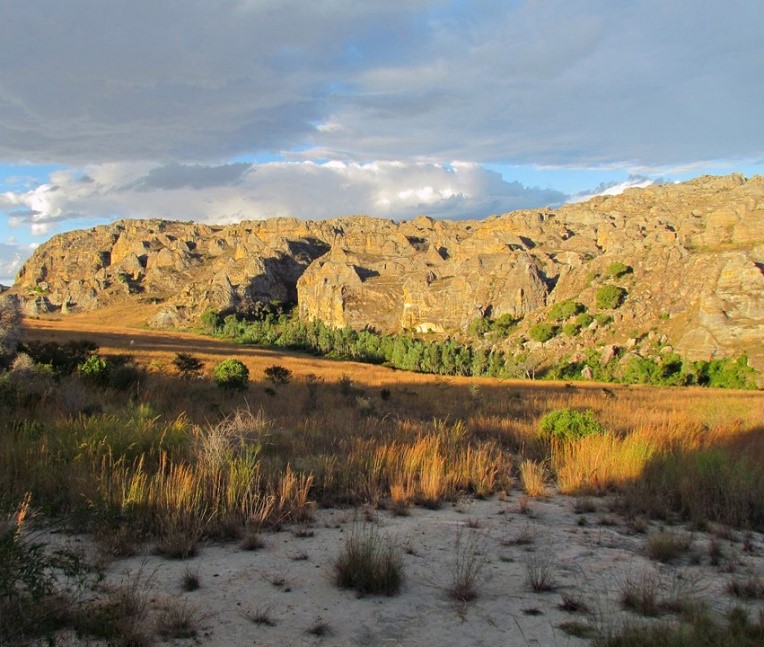
WHERE TO STAY NEAR ISALO NATIONAL PARK
Isalo Rock Lodge
The Isalo Rock Lodge is a modern lodge, set into the rocks, that has a beautiful view of the rock outcroppings. There is a swimming pool and very good restaurant here too. Do not miss the Isalo Rock Lodge if you are visiting this area.
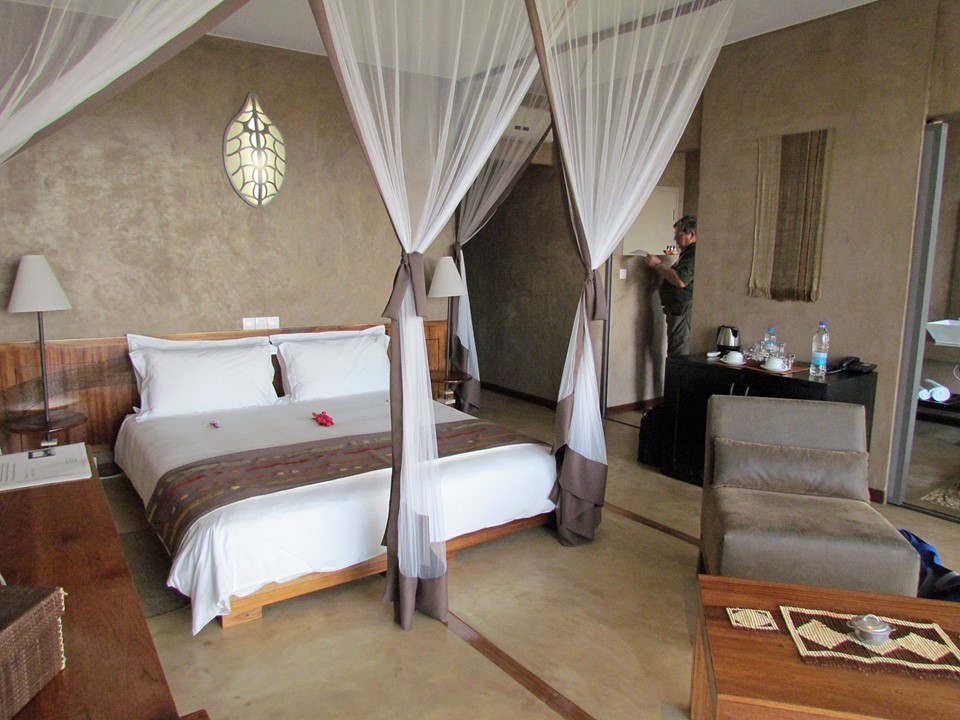
Our Drive From Isalo National Park to Toliara
We went through a lot of dry, hot areas on our way to the southwest coast.
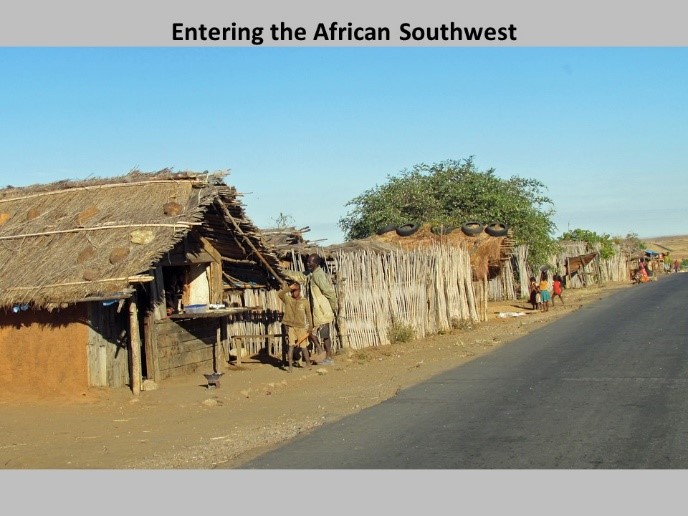
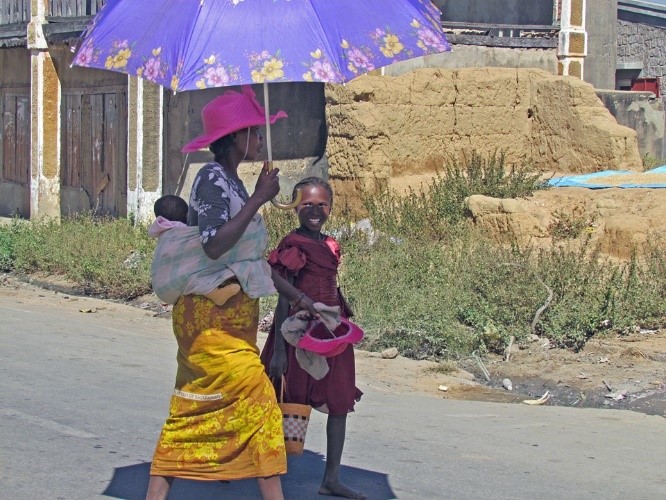
As we entered Southwest Madagascar, the land became much more arid. We went through very poor looking areas with dry dirt, desert plants and tiny African type villages of maybe 10 huts per village. These huts were made of sticks half the size of a person’s wrist set into the ground and smaller sticks woven horizontally with straw woven between the sticks to form walls. The huts were only maybe 10’ x 10’ big and the villages were very primitive and poor looking. Some of the better areas seemed to be able to grow cotton, sugar cane and corn.
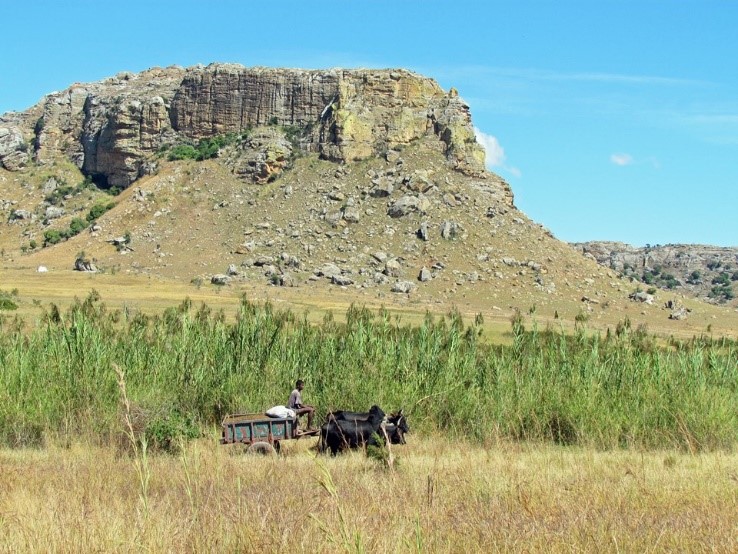
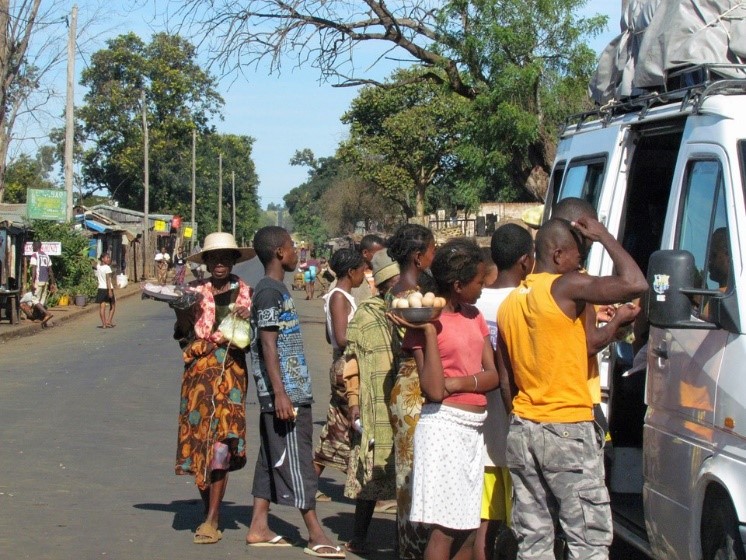
Tips for Driving in Southwest Madagascar- North of Toliara
This portion of our drive was on thick sand roads that were bumpy and full of potholes. And this was the main road up the coast and a national highway!
BAOBAB TREE PARK
The famous Baobab tree is located near Toliara. This imposing and unusual tree is endemic to the island of Madagascar, where it is an endangered species that is threatened by the encroachment of agricultural land.
Here we saw the Grandidier’s Baobab (also known as the Giant Baobab). Each of the Grandidier’s Baobabs have massive cylindrical trunks, with some that span up to 10’ across! They can reach 80’ tall or more. I think that they are such an interesting plant. They almost look like an upside down tree. The leaves only show a couple of months during the year, and the rest of the year, the top looks like the roots are up in the air. The tree trunks store water and the tree can go a year without water. They live a very long time and on our walking tour we saw some that were several hundred years old and one that was 1,200 years old!!
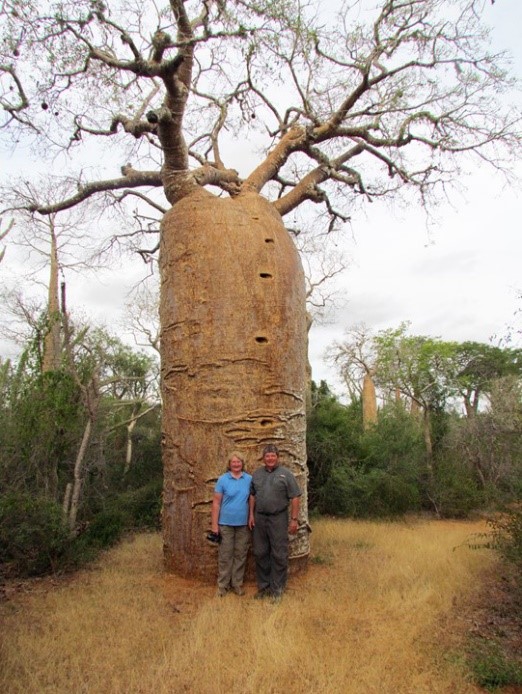
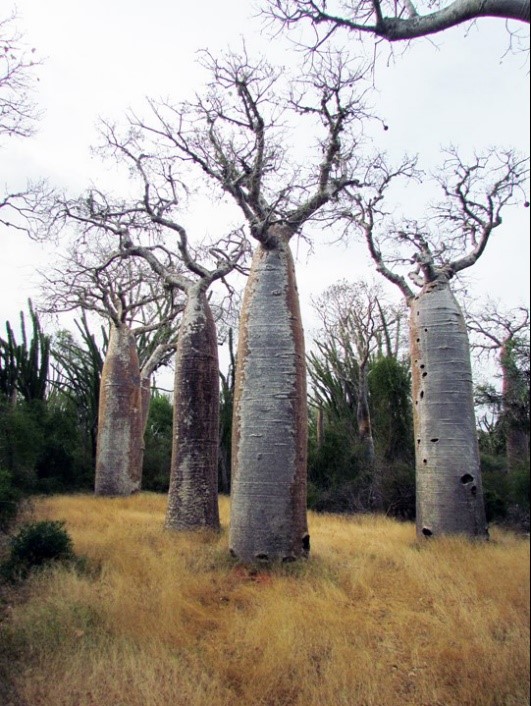
Our local tour guide here was also really good at spotting animals. Besides the six species of Baobab trees we saw, we also found many different animal species.
Our standout finds were scorpions, the giant hissing cockroach (scary!), spiders and lizards and numerous geckos. And then we found the cute Tenrec (which is like a small hedgehog).
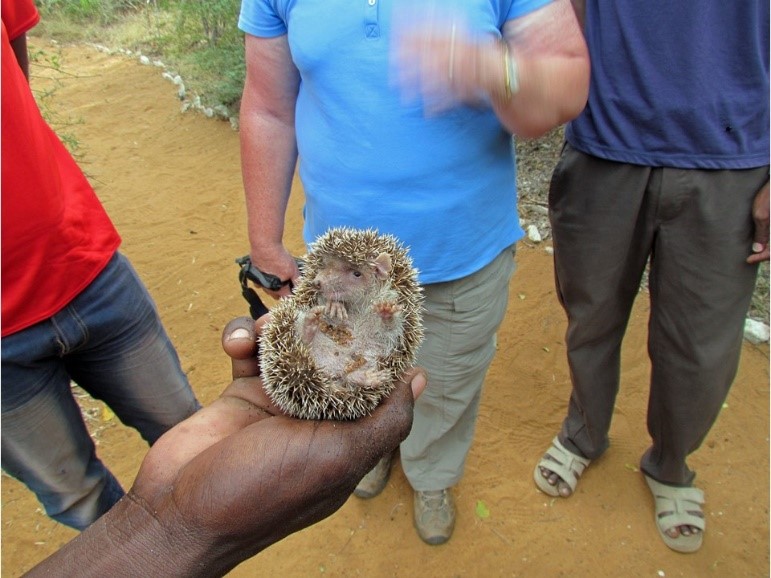
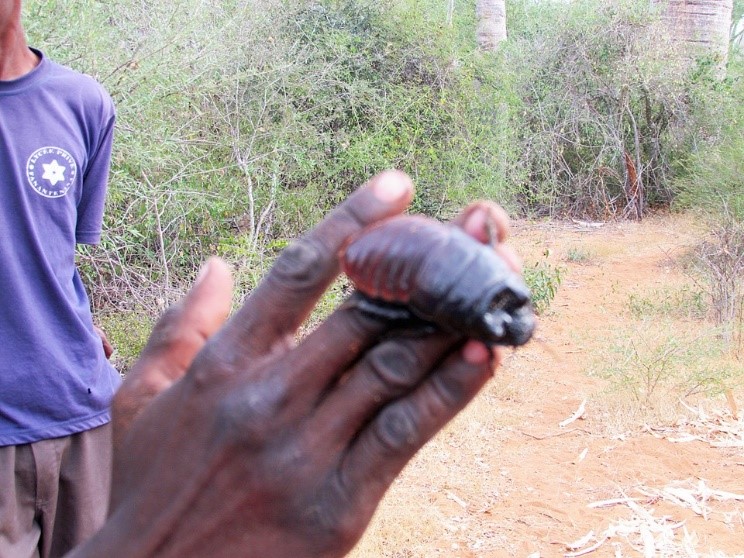
WHERE WE STAYED NEAR TOLIARA
We stayed north of Toliara at Les Dunes D’ifaty Lodge, which was right on the ocean! It was beautiful! We had open air rooms, mosquito nets and a nice fan. The dining was also very good here.
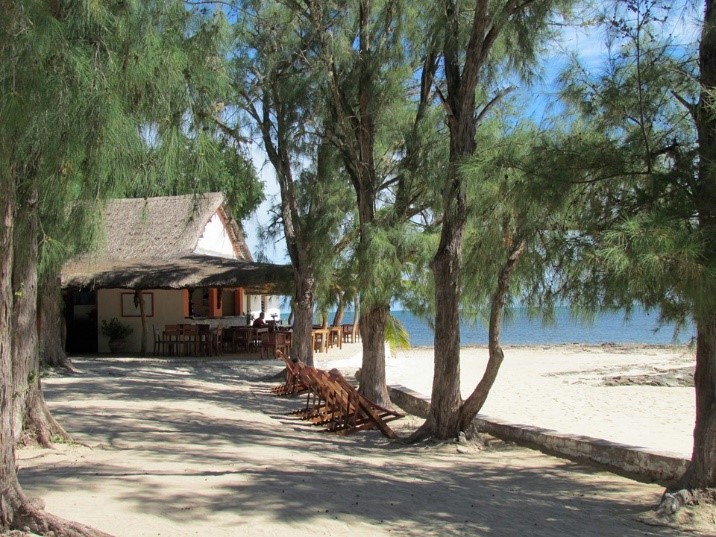
After a wonderful 13-day adventure, we flew back to the Capital and headed homeward. And all without using a tour company to plan our trip.
Our 13 days were spent with an educated Madagascar native who was proud of his country and his people. He learned that we really valued activities like the home visit, which was something he had never considered before. And he said that he will offer it to travelers on future trips. For our adventure, our guide planned 75% of the trip with our concurrence, and the remaining 25% was a joint effort. This method of traveling, with a local guide, provided us with exactly what we were looking for to discover the best of Madagascar. And it was an absolutely incredible adventure!
Goodbye to Madagascar – We Will Miss You!
If You Found This Post Helpful, Please Share / Pin It
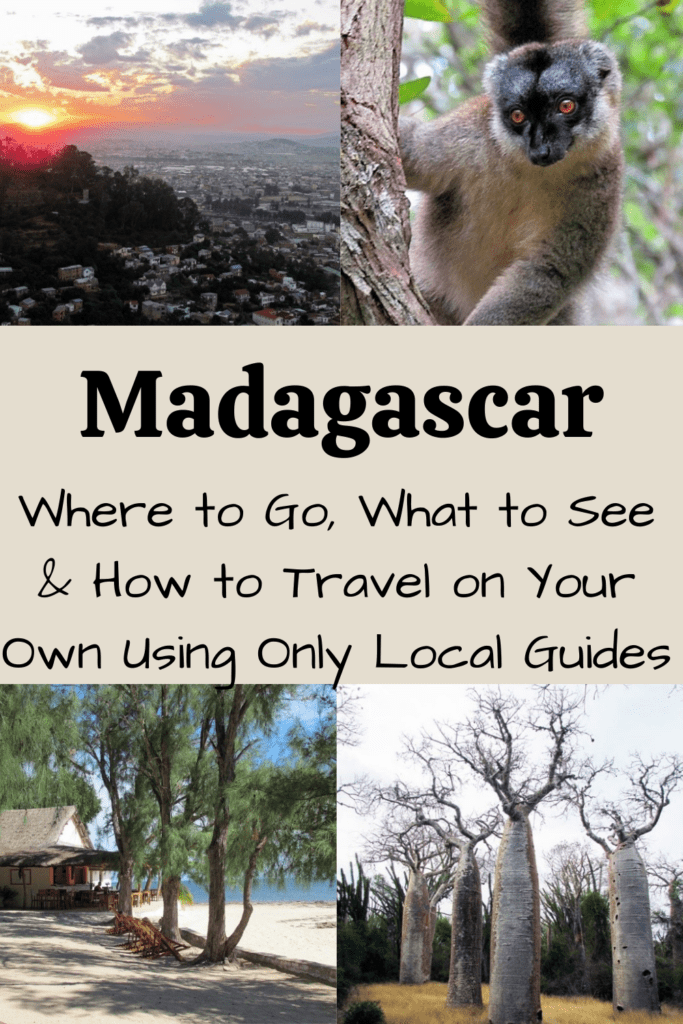
10 Traveling Feet is a participant of Amazon Associates which means means we may receive a small commission, at no cost to you, if you make a purchase through a link. Thank you for supporting 10 Traveling Feet.

